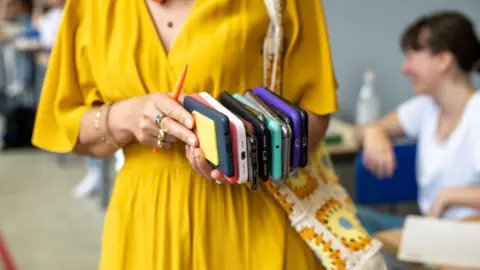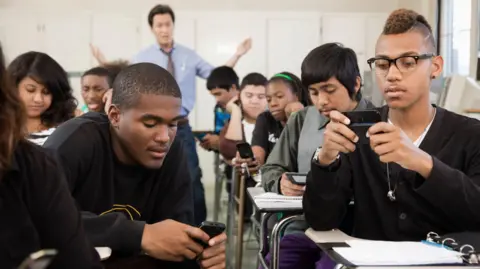By Ana Faguy, Laura Blasey and Regan Morris, BBC News, Washington and Los Angeles
 Getty
GettyAs a middle school teacher, Nancy Streit understands how difficult it can be to compete with a smartphone for a child’s attention.
But as a mother, she knows these devices are essential in an emergency.
“It’s mostly parents who call,” she said, adding that although she doesn’t allow phone use in her class, students routinely bend the rules.
The Los Angeles school district where Ms. Streit teaches — the second-largest school district in the country — is the latest to ban smartphone use in schools this week.
It’s part of a growing and familiar trend as more states and schools across the United States consider how to deal with children’s growing dependence on their devices.
New York and California, the two most populous U.S. states, are considering new statewide policies on the issue.
Earlier this week, California Governor Gavin Newsom called for a ban on smartphones in classrooms and said he would work with lawmakers on a policy. In New York, Governor Kathy Hochul has advocated for a similar law.
This spring, Indiana’s governor signed a law banning classrooms, which is expected to take effect in the fall.
The efforts mark the latest chapter in a long debate over controlling smartphone use in schools, and come amid a wave of concern about young people’s mental health in the wake of the pandemic.
Most American schools already have some sort of telephone policy. About 76% of schools have banned their use for non-academic purposes in the 2021-2022 school year, according to the US Department of Education.
The latest wave of regulations, however, seeks to go further.
Raphaela Hodges, a sixth-grade teacher at a Los Angeles school, says she’s seen a worrying and dramatic change in the way children socialize.
“When they don’t feel comfortable, they answer the phone,” she told the BBC.
It’s also an issue with rare bipartisan consensus, with lawmakers States controlled by Republicans and Democrats pursue similar policies.
Last year, Florida implemented a state law that required school districts to ban access to phones in classrooms and block access to social media on school Wi-Fi. school.
The law also requires schools to “provide education about the social, emotional, and physical effects of social media.”
Some state districts, including Maine and Virginia, are also instituting stricter rules regarding phone use, as are provinces in Canada, including Ontario and Alberta.
A debate that continues
Concerns about phones in schools have existed for almost as long as these devices have existed, with little consensus and much controversy.
The United States has seen several attempts to ban communication devices in classrooms since the 1980s.
Early critics worried that the phones could distract students and their association with drug trafficking.
But the 1999 shooting at Columbine High School in Colorado, in which 13 people died, led some parents and schools to re-evaluate the telephone as a key communications tool in an emergency. States have relaxed the rules, including California, which repealed a phone ban in 2002.
The debate was reignited as schools viewed the phone as a growing distraction, an aid to cyberbullying and a potential way for students to cheat on homework.
New York City, which has a total student population of more than 1 million, began imposing a strict ban — but reversed course in 2015 to allow individual schools to set policies.
 Getty Images
Getty ImagesSocial media use and student mental health
The current wave of policies comes as experts voice concerns about student mental health and social media use.
One of America’s top health officials on Monday called for warning labels similar to those on cigarette boxes on social media platforms.
Surgeon General Vivek Murthy has argued that social media increases the risk of children experiencing symptoms of anxiety and depression, although research on the subject is mixed.
“You have a situation where kids are not only trying to learn, but they’re simultaneously on their phones, they’re texting their friends, they’re responding to messages on social media, they’re scrolling through their feeds,” Dr Murthy told the BBC.
“This makes it very difficult not only to learn, but also to build relationships and friendships at school.”
Teenagers who spend more than three hours a day on social media face double the risk of mental health problems, such as anxiety and depression, according to a study published in 2019 and frequently cited by federal social media offices. health.
Will it work?
Will the policy change last? Schools have always struggled to balance security with limiting social media sirens.
Ken Trump, president of the National School Safety and Security Services, said policies won’t work without strong community consensus and consistent enforcement.
“There’s a lot more to it than the average parent or anyone looking from afar thinks. It’s a thorny issue, it’s very complex,” Mr. Trump said.
In Los Angeles, board members voted Tuesday to ban the devices starting next year. But how this policy will work is still unclear.
Alyssa, an 18-year-old from Los Angeles, where many schools have thousands of students, told the BBC she couldn’t imagine being in high school without a phone.
“We have huge campuses – no one can monitor all of that,” she said. “There are tons of places you can go without being seen.”


